Assignment: Education Curriculum Development and Bloom's Taxonomy
VerifiedAdded on 2023/01/06
|7
|1367
|2
Homework Assignment
AI Summary
This assignment delves into the realm of education curriculum development, focusing on Bloom's Taxonomy. It begins with an introduction to curriculum development and its importance, followed by a detailed review of the revised Bloom's Taxonomy, including its elements and cognitive processes. The assignment emphasizes the need to develop students across cognitive, affective, and psychomotor domains. The main body of the assignment includes an analysis of Bloom's Taxonomy and presents activities tailored to each level of the cognitive domain for the subject of business studies, specifically focusing on the principles of management. These activities, including story-telling, debates, case study evaluations, and brainstorming, are designed to enhance students' understanding and application of the principles. The conclusion summarizes the significance of Bloom's Taxonomy for educators. The assignment is supported by relevant references to academic sources.
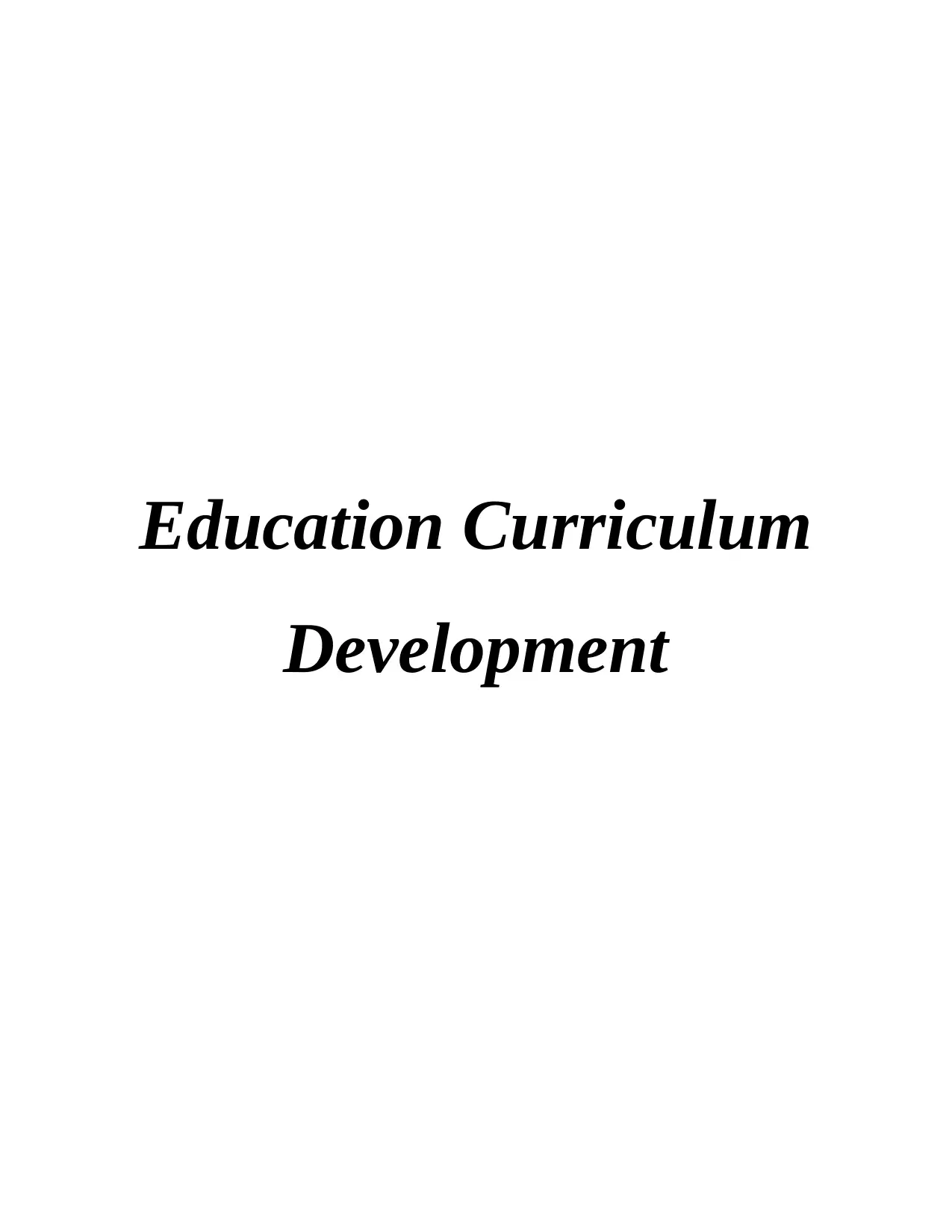
Education Curriculum
Development
Development
Paraphrase This Document
Need a fresh take? Get an instant paraphrase of this document with our AI Paraphraser
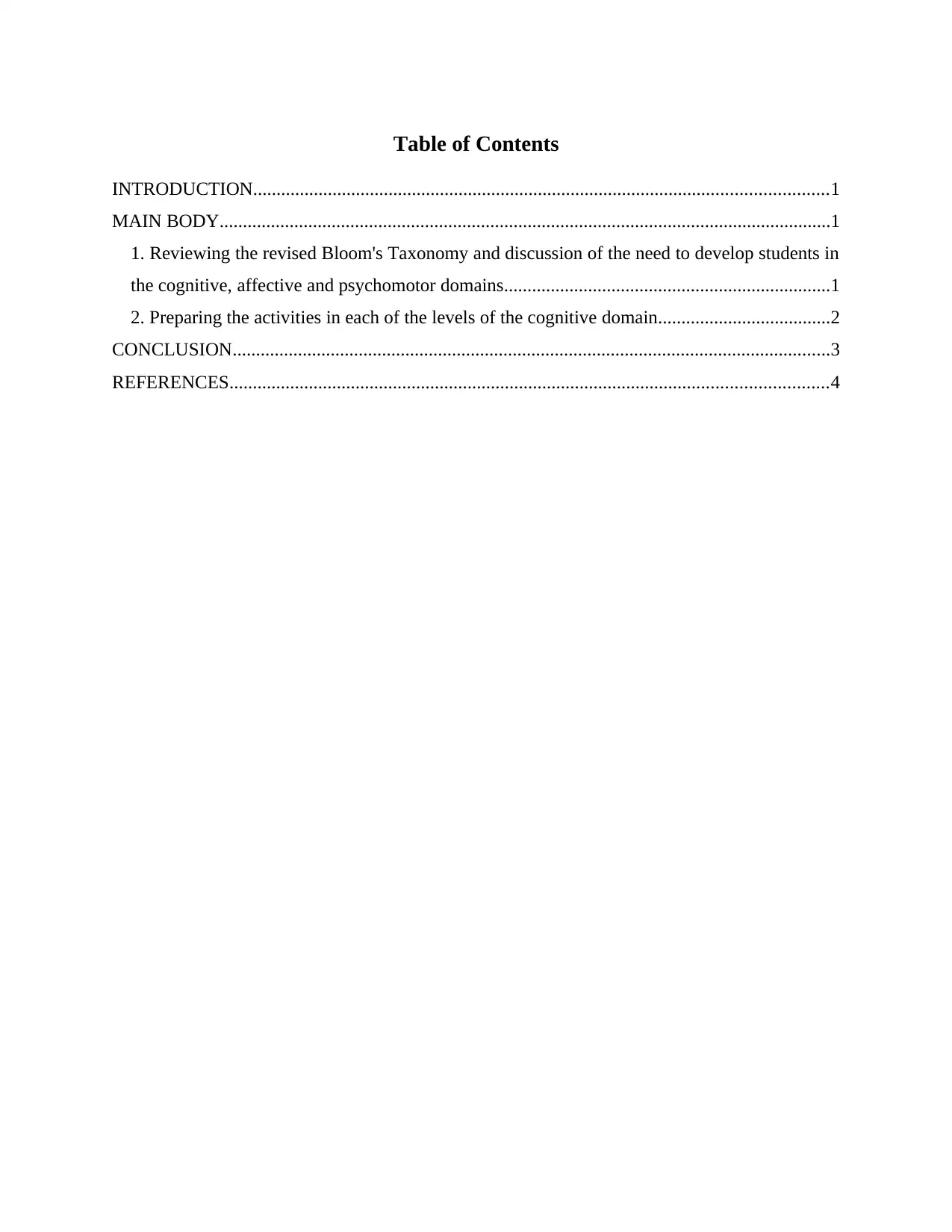
Table of Contents
INTRODUCTION...........................................................................................................................1
MAIN BODY...................................................................................................................................1
1. Reviewing the revised Bloom's Taxonomy and discussion of the need to develop students in
the cognitive, affective and psychomotor domains......................................................................1
2. Preparing the activities in each of the levels of the cognitive domain.....................................2
CONCLUSION................................................................................................................................3
REFERENCES................................................................................................................................4
INTRODUCTION...........................................................................................................................1
MAIN BODY...................................................................................................................................1
1. Reviewing the revised Bloom's Taxonomy and discussion of the need to develop students in
the cognitive, affective and psychomotor domains......................................................................1
2. Preparing the activities in each of the levels of the cognitive domain.....................................2
CONCLUSION................................................................................................................................3
REFERENCES................................................................................................................................4
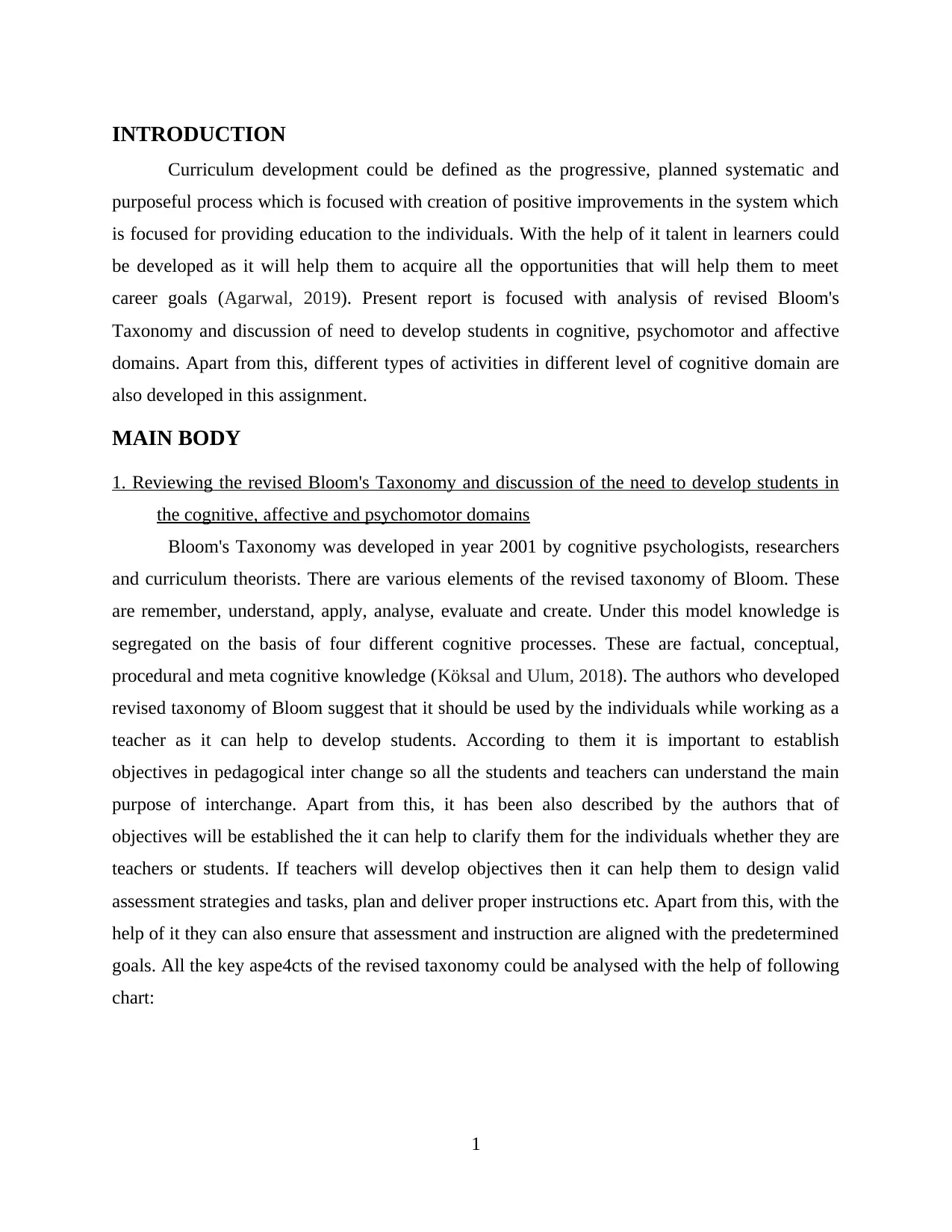
INTRODUCTION
Curriculum development could be defined as the progressive, planned systematic and
purposeful process which is focused with creation of positive improvements in the system which
is focused for providing education to the individuals. With the help of it talent in learners could
be developed as it will help them to acquire all the opportunities that will help them to meet
career goals (Agarwal, 2019). Present report is focused with analysis of revised Bloom's
Taxonomy and discussion of need to develop students in cognitive, psychomotor and affective
domains. Apart from this, different types of activities in different level of cognitive domain are
also developed in this assignment.
MAIN BODY
1. Reviewing the revised Bloom's Taxonomy and discussion of the need to develop students in
the cognitive, affective and psychomotor domains
Bloom's Taxonomy was developed in year 2001 by cognitive psychologists, researchers
and curriculum theorists. There are various elements of the revised taxonomy of Bloom. These
are remember, understand, apply, analyse, evaluate and create. Under this model knowledge is
segregated on the basis of four different cognitive processes. These are factual, conceptual,
procedural and meta cognitive knowledge (Köksal and Ulum, 2018). The authors who developed
revised taxonomy of Bloom suggest that it should be used by the individuals while working as a
teacher as it can help to develop students. According to them it is important to establish
objectives in pedagogical inter change so all the students and teachers can understand the main
purpose of interchange. Apart from this, it has been also described by the authors that of
objectives will be established the it can help to clarify them for the individuals whether they are
teachers or students. If teachers will develop objectives then it can help them to design valid
assessment strategies and tasks, plan and deliver proper instructions etc. Apart from this, with the
help of it they can also ensure that assessment and instruction are aligned with the predetermined
goals. All the key aspe4cts of the revised taxonomy could be analysed with the help of following
chart:
1
Curriculum development could be defined as the progressive, planned systematic and
purposeful process which is focused with creation of positive improvements in the system which
is focused for providing education to the individuals. With the help of it talent in learners could
be developed as it will help them to acquire all the opportunities that will help them to meet
career goals (Agarwal, 2019). Present report is focused with analysis of revised Bloom's
Taxonomy and discussion of need to develop students in cognitive, psychomotor and affective
domains. Apart from this, different types of activities in different level of cognitive domain are
also developed in this assignment.
MAIN BODY
1. Reviewing the revised Bloom's Taxonomy and discussion of the need to develop students in
the cognitive, affective and psychomotor domains
Bloom's Taxonomy was developed in year 2001 by cognitive psychologists, researchers
and curriculum theorists. There are various elements of the revised taxonomy of Bloom. These
are remember, understand, apply, analyse, evaluate and create. Under this model knowledge is
segregated on the basis of four different cognitive processes. These are factual, conceptual,
procedural and meta cognitive knowledge (Köksal and Ulum, 2018). The authors who developed
revised taxonomy of Bloom suggest that it should be used by the individuals while working as a
teacher as it can help to develop students. According to them it is important to establish
objectives in pedagogical inter change so all the students and teachers can understand the main
purpose of interchange. Apart from this, it has been also described by the authors that of
objectives will be established the it can help to clarify them for the individuals whether they are
teachers or students. If teachers will develop objectives then it can help them to design valid
assessment strategies and tasks, plan and deliver proper instructions etc. Apart from this, with the
help of it they can also ensure that assessment and instruction are aligned with the predetermined
goals. All the key aspe4cts of the revised taxonomy could be analysed with the help of following
chart:
1
⊘ This is a preview!⊘
Do you want full access?
Subscribe today to unlock all pages.

Trusted by 1+ million students worldwide
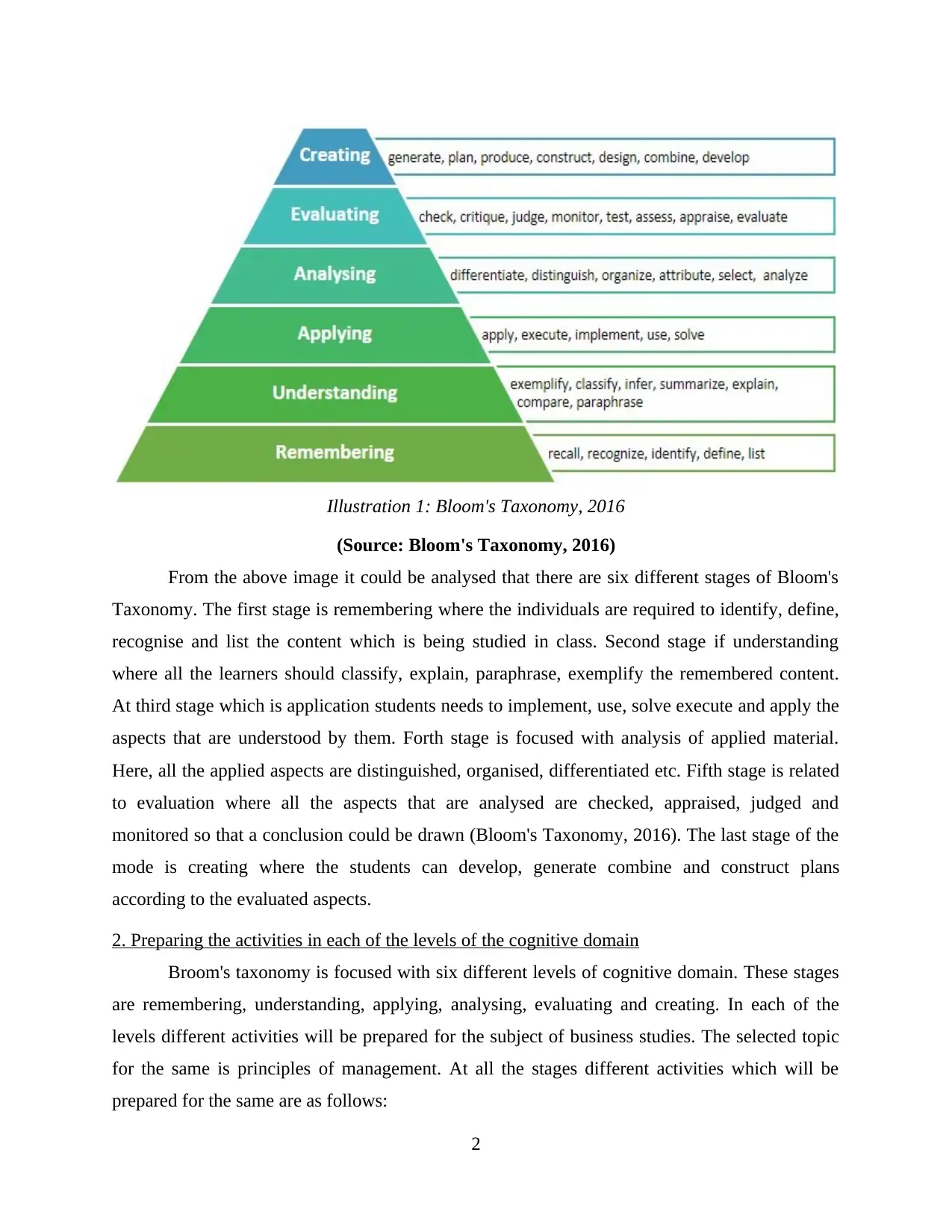
Illustration 1: Bloom's Taxonomy, 2016
(Source: Bloom's Taxonomy, 2016)
From the above image it could be analysed that there are six different stages of Bloom's
Taxonomy. The first stage is remembering where the individuals are required to identify, define,
recognise and list the content which is being studied in class. Second stage if understanding
where all the learners should classify, explain, paraphrase, exemplify the remembered content.
At third stage which is application students needs to implement, use, solve execute and apply the
aspects that are understood by them. Forth stage is focused with analysis of applied material.
Here, all the applied aspects are distinguished, organised, differentiated etc. Fifth stage is related
to evaluation where all the aspects that are analysed are checked, appraised, judged and
monitored so that a conclusion could be drawn (Bloom's Taxonomy, 2016). The last stage of the
mode is creating where the students can develop, generate combine and construct plans
according to the evaluated aspects.
2. Preparing the activities in each of the levels of the cognitive domain
Broom's taxonomy is focused with six different levels of cognitive domain. These stages
are remembering, understanding, applying, analysing, evaluating and creating. In each of the
levels different activities will be prepared for the subject of business studies. The selected topic
for the same is principles of management. At all the stages different activities which will be
prepared for the same are as follows:
2
(Source: Bloom's Taxonomy, 2016)
From the above image it could be analysed that there are six different stages of Bloom's
Taxonomy. The first stage is remembering where the individuals are required to identify, define,
recognise and list the content which is being studied in class. Second stage if understanding
where all the learners should classify, explain, paraphrase, exemplify the remembered content.
At third stage which is application students needs to implement, use, solve execute and apply the
aspects that are understood by them. Forth stage is focused with analysis of applied material.
Here, all the applied aspects are distinguished, organised, differentiated etc. Fifth stage is related
to evaluation where all the aspects that are analysed are checked, appraised, judged and
monitored so that a conclusion could be drawn (Bloom's Taxonomy, 2016). The last stage of the
mode is creating where the students can develop, generate combine and construct plans
according to the evaluated aspects.
2. Preparing the activities in each of the levels of the cognitive domain
Broom's taxonomy is focused with six different levels of cognitive domain. These stages
are remembering, understanding, applying, analysing, evaluating and creating. In each of the
levels different activities will be prepared for the subject of business studies. The selected topic
for the same is principles of management. At all the stages different activities which will be
prepared for the same are as follows:
2
Paraphrase This Document
Need a fresh take? Get an instant paraphrase of this document with our AI Paraphraser
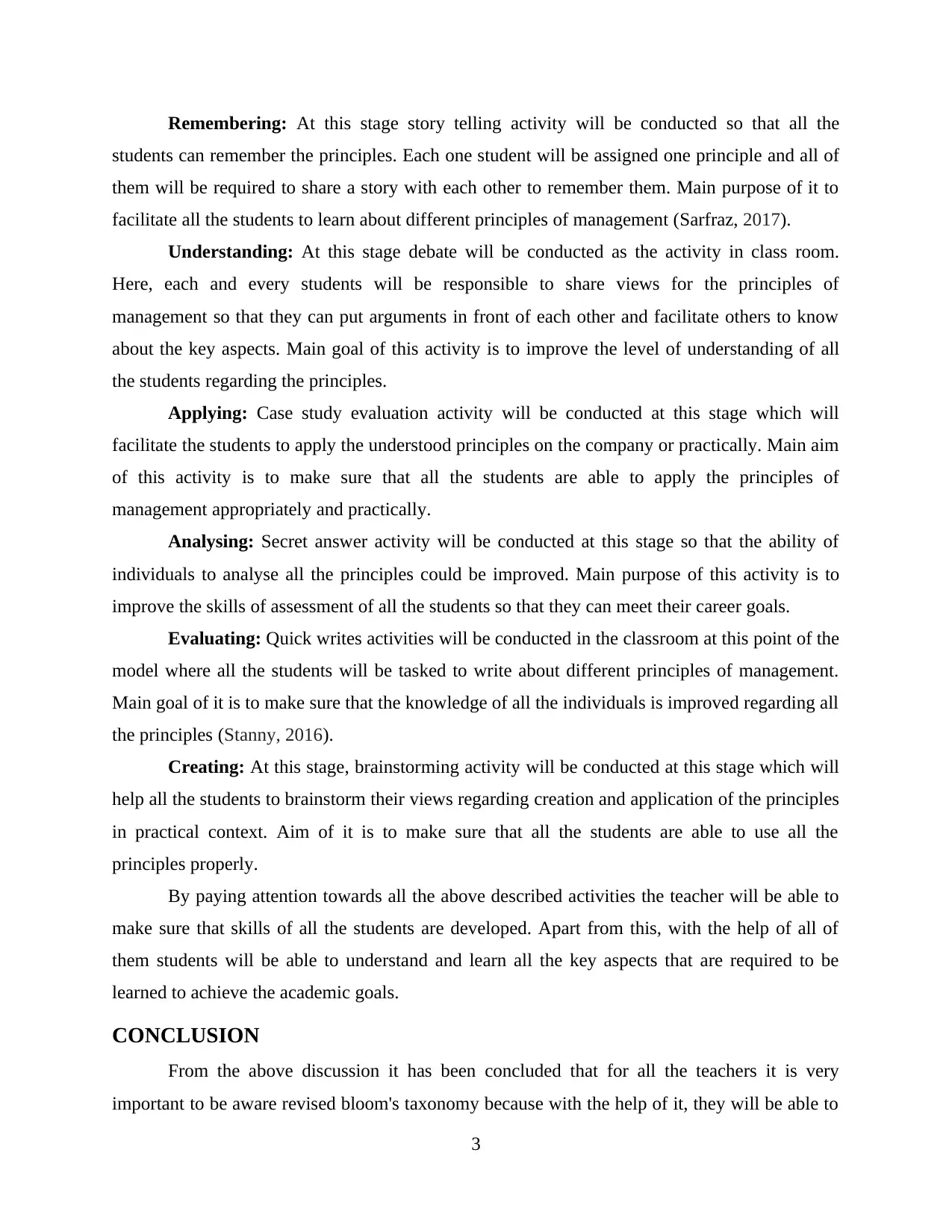
Remembering: At this stage story telling activity will be conducted so that all the
students can remember the principles. Each one student will be assigned one principle and all of
them will be required to share a story with each other to remember them. Main purpose of it to
facilitate all the students to learn about different principles of management (Sarfraz, 2017).
Understanding: At this stage debate will be conducted as the activity in class room.
Here, each and every students will be responsible to share views for the principles of
management so that they can put arguments in front of each other and facilitate others to know
about the key aspects. Main goal of this activity is to improve the level of understanding of all
the students regarding the principles.
Applying: Case study evaluation activity will be conducted at this stage which will
facilitate the students to apply the understood principles on the company or practically. Main aim
of this activity is to make sure that all the students are able to apply the principles of
management appropriately and practically.
Analysing: Secret answer activity will be conducted at this stage so that the ability of
individuals to analyse all the principles could be improved. Main purpose of this activity is to
improve the skills of assessment of all the students so that they can meet their career goals.
Evaluating: Quick writes activities will be conducted in the classroom at this point of the
model where all the students will be tasked to write about different principles of management.
Main goal of it is to make sure that the knowledge of all the individuals is improved regarding all
the principles (Stanny, 2016).
Creating: At this stage, brainstorming activity will be conducted at this stage which will
help all the students to brainstorm their views regarding creation and application of the principles
in practical context. Aim of it is to make sure that all the students are able to use all the
principles properly.
By paying attention towards all the above described activities the teacher will be able to
make sure that skills of all the students are developed. Apart from this, with the help of all of
them students will be able to understand and learn all the key aspects that are required to be
learned to achieve the academic goals.
CONCLUSION
From the above discussion it has been concluded that for all the teachers it is very
important to be aware revised bloom's taxonomy because with the help of it, they will be able to
3
students can remember the principles. Each one student will be assigned one principle and all of
them will be required to share a story with each other to remember them. Main purpose of it to
facilitate all the students to learn about different principles of management (Sarfraz, 2017).
Understanding: At this stage debate will be conducted as the activity in class room.
Here, each and every students will be responsible to share views for the principles of
management so that they can put arguments in front of each other and facilitate others to know
about the key aspects. Main goal of this activity is to improve the level of understanding of all
the students regarding the principles.
Applying: Case study evaluation activity will be conducted at this stage which will
facilitate the students to apply the understood principles on the company or practically. Main aim
of this activity is to make sure that all the students are able to apply the principles of
management appropriately and practically.
Analysing: Secret answer activity will be conducted at this stage so that the ability of
individuals to analyse all the principles could be improved. Main purpose of this activity is to
improve the skills of assessment of all the students so that they can meet their career goals.
Evaluating: Quick writes activities will be conducted in the classroom at this point of the
model where all the students will be tasked to write about different principles of management.
Main goal of it is to make sure that the knowledge of all the individuals is improved regarding all
the principles (Stanny, 2016).
Creating: At this stage, brainstorming activity will be conducted at this stage which will
help all the students to brainstorm their views regarding creation and application of the principles
in practical context. Aim of it is to make sure that all the students are able to use all the
principles properly.
By paying attention towards all the above described activities the teacher will be able to
make sure that skills of all the students are developed. Apart from this, with the help of all of
them students will be able to understand and learn all the key aspects that are required to be
learned to achieve the academic goals.
CONCLUSION
From the above discussion it has been concluded that for all the teachers it is very
important to be aware revised bloom's taxonomy because with the help of it, they will be able to
3

guide all the students properly. Some of the main stages of it are remembering, understanding,
applying, analysing, evaluating and creating.
4
applying, analysing, evaluating and creating.
4
⊘ This is a preview!⊘
Do you want full access?
Subscribe today to unlock all pages.

Trusted by 1+ million students worldwide
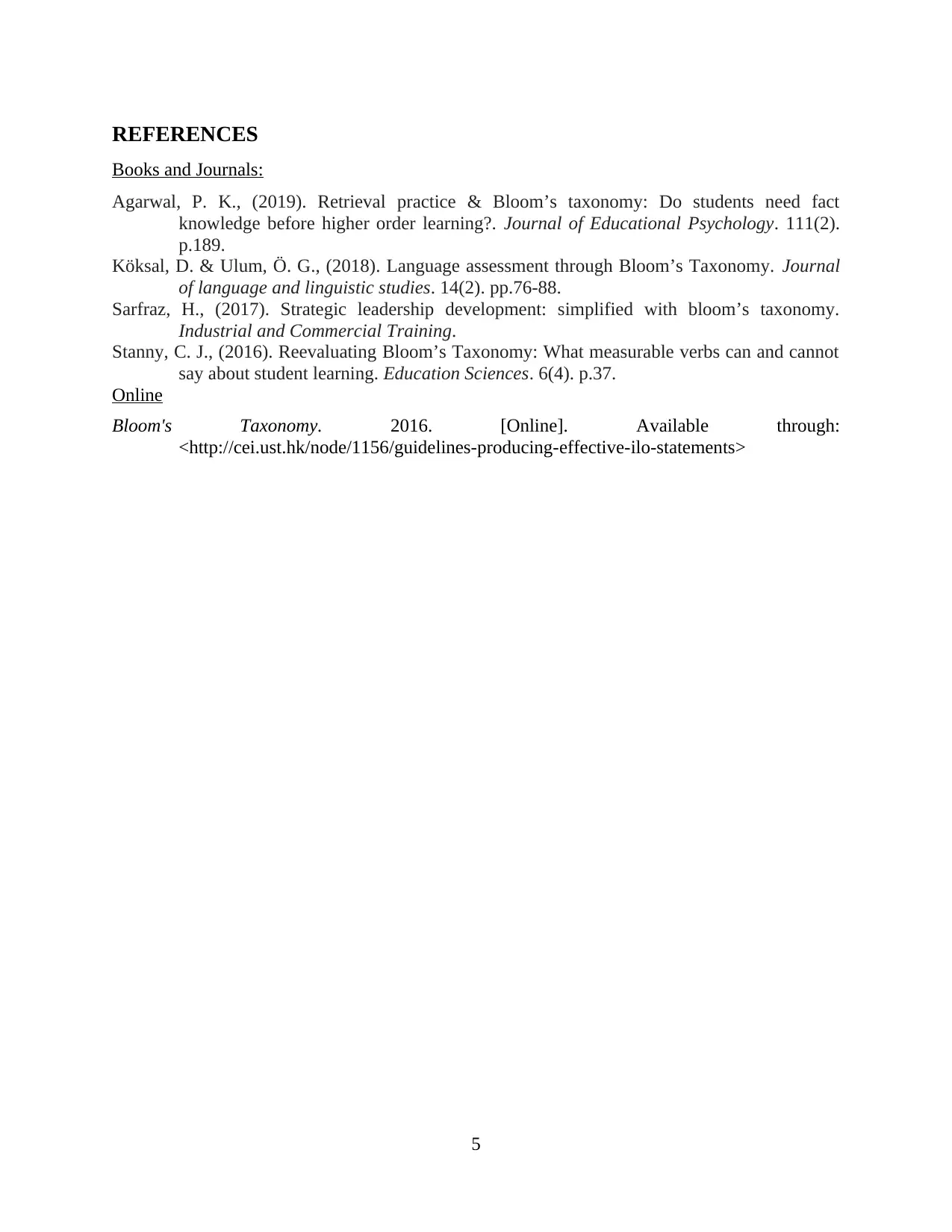
REFERENCES
Books and Journals:
Agarwal, P. K., (2019). Retrieval practice & Bloom’s taxonomy: Do students need fact
knowledge before higher order learning?. Journal of Educational Psychology. 111(2).
p.189.
Köksal, D. & Ulum, Ö. G., (2018). Language assessment through Bloom’s Taxonomy. Journal
of language and linguistic studies. 14(2). pp.76-88.
Sarfraz, H., (2017). Strategic leadership development: simplified with bloom’s taxonomy.
Industrial and Commercial Training.
Stanny, C. J., (2016). Reevaluating Bloom’s Taxonomy: What measurable verbs can and cannot
say about student learning. Education Sciences. 6(4). p.37.
Online
Bloom's Taxonomy. 2016. [Online]. Available through:
<http://cei.ust.hk/node/1156/guidelines-producing-effective-ilo-statements>
5
Books and Journals:
Agarwal, P. K., (2019). Retrieval practice & Bloom’s taxonomy: Do students need fact
knowledge before higher order learning?. Journal of Educational Psychology. 111(2).
p.189.
Köksal, D. & Ulum, Ö. G., (2018). Language assessment through Bloom’s Taxonomy. Journal
of language and linguistic studies. 14(2). pp.76-88.
Sarfraz, H., (2017). Strategic leadership development: simplified with bloom’s taxonomy.
Industrial and Commercial Training.
Stanny, C. J., (2016). Reevaluating Bloom’s Taxonomy: What measurable verbs can and cannot
say about student learning. Education Sciences. 6(4). p.37.
Online
Bloom's Taxonomy. 2016. [Online]. Available through:
<http://cei.ust.hk/node/1156/guidelines-producing-effective-ilo-statements>
5
1 out of 7
Related Documents
Your All-in-One AI-Powered Toolkit for Academic Success.
+13062052269
info@desklib.com
Available 24*7 on WhatsApp / Email
![[object Object]](/_next/static/media/star-bottom.7253800d.svg)
Unlock your academic potential
Copyright © 2020–2025 A2Z Services. All Rights Reserved. Developed and managed by ZUCOL.





